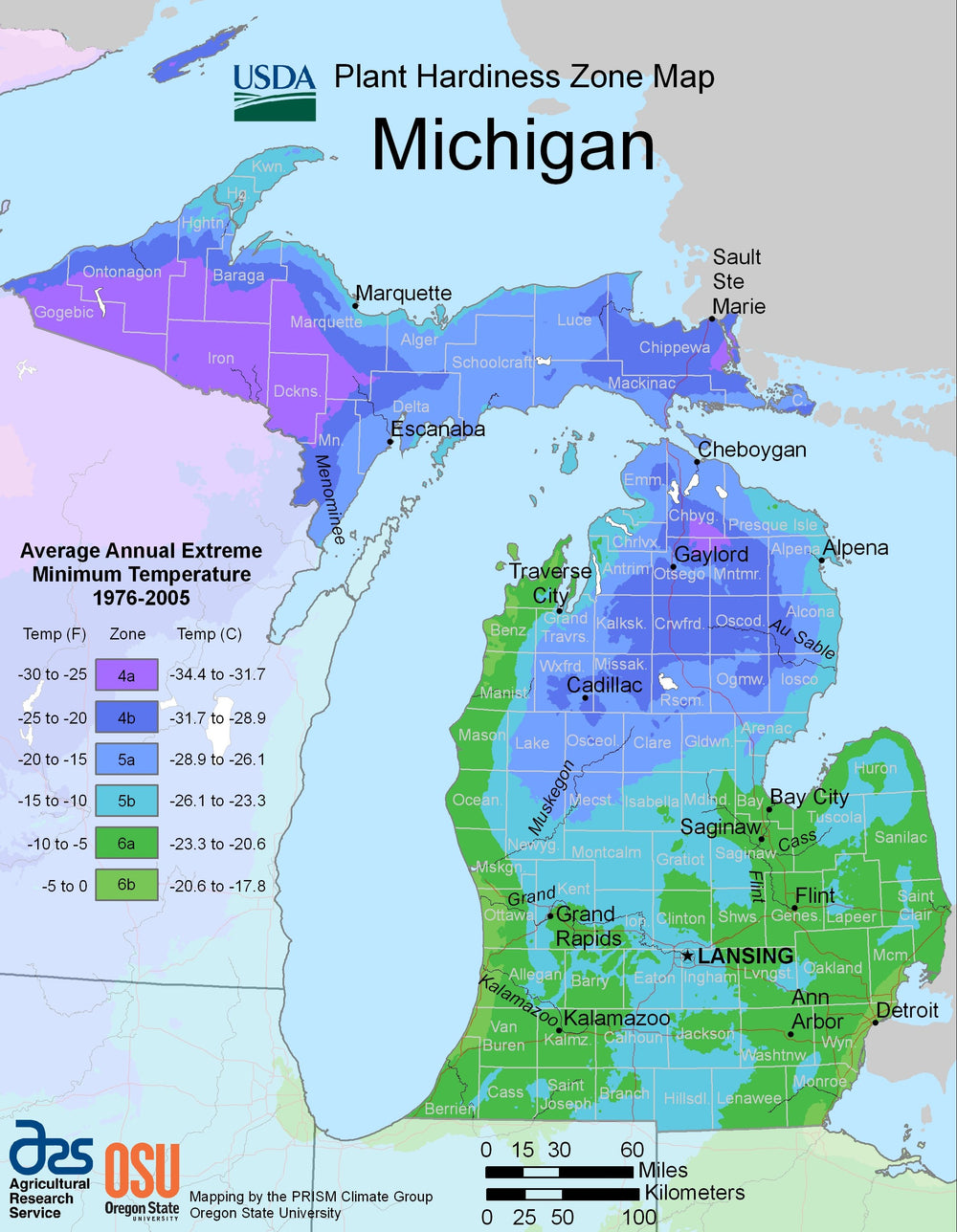Image from USDA
Characteristics of Michigan Planting Region
The state of Michigan has a continental climate; however, the area can be divided into two distinct climate regions.
-
Southern and Central
This part of the state experiences a much warmer climate with hot summers and cold winters.
-
Northern Lower Peninsula and Upper Peninsula
This area commonly has short, warm summers and extremely harsh and long winters.
Most of the state is also prone to severe weather such as thunderstorms, tornadoes, wind storms, blizzards, floods, and heavy snowfall.
The growing season in this region is very brief, and frost dates will vary dramatically across the state. The typical frost-free period can begin anywhere between mid-April and the end of May and finish between September and the beginning of November.

Michigan in Autumn
Challenges of Growing in Michigan
1. Shorter Growing Season
Michiganders can expect a very limited planting season, with only a few frost-free months annually. Many warmer season crops will struggle to mature within this short timeframe, so it’s crucial for gardeners to plan ahead and potentially start their seeds indoors.
2. Severe Weather
The extreme weather conditions across the region make gardening difficult throughout the year. In many cases, it’s wise to utilize a protective covering to avoid the disappointment of your plants being damaged by thunderstorms, wind, tornadoes, and more.
3. Long, Cold Winters
Extremely harsh and long winters pose difficulties for gardeners who wish to extend their growing season outdoors. While a combination of indoor and outdoor growing could be beneficial, the abundant snowfall may hinder any efforts to grow into the winter months.

Winter in Michigan
The Benefits of Using a Greenhouse in Michigan
Short growing seasons, extreme weather, and harsh winters make Michigan the perfect candidate for greenhouse planting. A greenhouse will protect your hard work from the temperamental weather and dramatically extend your growing timeframes, allowing you to plant a much wider variety of vegetables.
Extend your Growing Season
-
Without a Greenhouse:
The average outdoor growing timeframe in Michigan ranges between 3-4 months annually. The season is relatively short, meaning many plants will require an element of indoor growing in order to mature in time before the first frost of the year.
-
With a Greenhouse:
Greenhouse gardeners can expect an extended growing season of between 6-8 months, depending on which part of the state you’re located. While this is already doubling the standard growing season, those utilizing a greenhouse heater can potentially continue gardening throughout the entire year.
Learn more about specific growing dates for your area and the best vegetables to plant in each part of Michigan.


Customer images of the Sungrow Greenhouse in Vanderbilt, Michigan.
Vegetables you can Grow in Michigan
The short planting season and frigid winters mean many gardeners are limited to short-season and cold-hardy vegetables that can either mature quickly or survive the first frost of the year. Some of the vegetables known to survive the short planting timeframes include:
- Peas
- Broccoli
- Lettuce
- Radishes
- Cabbage
- Kale
- Collard Greens
-
Turnips
Greenhouse growing allows gardeners to plant a much wider variety of vegetables. Without the limitations of the short outdoor growing season, gardeners can experiment with more long-season and warm-season plants. Some of the vegetables known to thrive in a greenhouse in Michigan include:
- Sweet Corn
- Carrots
- Tomatoes
- Zucchini
- Green Beans
- Cucumbers
- Asparagus
- Celery
- Pinto Beans
- Onions
- Potatoes
- Pumpkin
- Squash
- Black Beans
- Eggplants
- Peppers
- Beets
- Brussel Sprouts
- Cauliflower
- Gourds
- Okra
- Sweet Potatoes
- Watermelon
- Kidney Beans
- Cowpeas
- Cantaloupe
- Jalapeño
-
Sugar Snap Peas

Cucumbers growing in Greenhouse
Why Planta Greenhouses?
- Wind resistant up to 65 mph (learn more about how our greenhouses hold up in high-altitude climates).
- Withstands a snow load of up to 98 psf (480kg/square meter).
- Made with a heavy-duty galvanized steel frame.
- Polycarbonate panels provide 100% protection against UV rays.
- The Sungrow greenhouse is bell-shaped - allows the wind, snow, and hail to slide off the sides.
- Extendable (Sungrow, Sigma and Farmer models can be extended beyond 100ft)
- Made in Europe and are exclusively imported
- Maintenance-free

